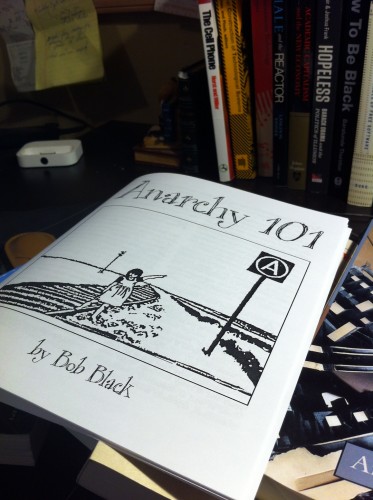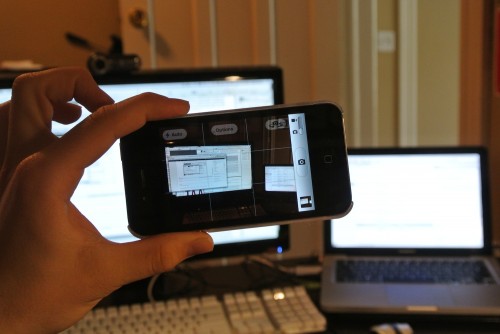I want to start out by saying that “liberatory” is not in the standard OS X spell check dictionary. There aren’t even spelling suggestions. It is totally foreign. I think that’s telling. Also, our blog’s CSS prevents us from giving our entries long titles. The Title is part of the story, so let me put it in a more readable format:
Black Box Tactics: The Liberatory Potential of Obscuring The Inner Workings of Technology
There we go. Now where was I? Oh right, I haven’t started yet. Let me do that:
I was reading Winner’s “Upon Opening the Black Box and Finding it Empty: Social Constructivism and the Philosophy of Technology” [PDF] for a paper I’m writing on the role of play in urban design, when I glanced at my desk:
The two bounced around in my brain and I ended up tweeting this:
https://twitter.com/#!/DA_Banks/status/198848697667293184
Get it? Black bloc tactics, black box metaphors? It was an off-the-cuff comment, but before too long, three people had retweeted it and I had gotten some replies:
https://twitter.com/#!/thejaymo/status/198849191169105920
https://twitter.com/#!/Call_Me_Ismail/status/198850512987230209
https://twitter.com/#!/nathanjurgenson/status/198852926872104960
So now I was a little confused. Had I hit on something? Had I just inadvertently made some kind of art criticism? I wasn’t even thinking of The New Aesthetic when I wrote the tweet!
Moment of absolute honesty: I just double-checked what the New Aesthetic was. Like, right after I wrote that last sentence I did a Google search and re-read this. I’m pretty sure I get what @thejaymo was saying now. The New Aesthetic isn’t an art form or a style– it’s the inevitable consequence of our augmented reality. It’s about noticing the process and the environment, a kind of brutal honesty that plays with these new frames of reference that went from prototype to ubiquity in under a decade:
I’m not going to pretend that what I just did was original, but a blog doesn’t give you a whole lot of space to make my point, so I’m willing to sacrifice subtly for clarity. Just like the iphone 4’s camera. You miss the detail, but the whole photo looks pretty good. And, as we all know, we are doing much more than creating an accurate visual record of events when we use our cameras. The sociologist in me is tempted to use Bourdieu’s Distinction to analyze what’s going on here, and I encourage you to read the wikipedia summary [^^^^ I just linked to it up there] and draw your own conclusions. For example, one might conclude that the “working class New Aesthetic” (if there is one) is dictated by their limited choices for online connection. It looks like second-hand smartphones with a small chip in the screen, or the whole experience is framed by the internet access terminal at their local library with an outdated browser. But I don’t feel like I’m on solid ground here. I would have to hit the stacks again before writing that post. Instead, I want to come back to where I started: Langdon Winner’s article.
To call X a “black box” (noun) or to “black box” X (verb) means you are unconcerned with the inner workings of X. Instead, X is defined by what goes in and what comes out. For most people, an iPhone is a black box because you understand what goes into it –photons, sound waves, and your touch on the screen– and what comes out —images, voice, text— but how the inputs turn into outputs is pretty much a mystery to you. I imagine it has something to do with microchips, precision-cut aluminum, and the violence of global capitalism. Winner’s article is a response to a new (at the time, 1993) mode of inquiry called the social construction of technology (SCOT). These social constructivists were mostly historians and sociologists who would look at the histories of various artifacts (bicycles, bakelite, and light bulbs for example) and reveal the paths not taken. For example, at the turn of the 20th century bicycles were considered to be a toy of the aristocracy. Men would show how fearless and rugged they were by riding these dangerous machines:

Social constructivists show that the design of modern bicycles was influenced by all sorts of social factors and the resulting artifact is contingent upon these social factors. The bicycle, social constructivists tend to say, has interpretive flexibility. My idea of what makes a good bike is different from yours and our differing perspectives compete within a social milieu to define future bicycles. It’s a really useful theory, because it lets you say, “it could have been otherwise” and from there, you can get a better understanding of humans’ relationship to their creations. Historical contingencies are good to think with because it reveals how much of our sociotechnical world is shaped and framed by decisions we never knew were made. It also blurs the boundary between the social and the technical; the cultural and the natural. I don’t want to get into actor network theory, so lets just leave it at this: Our technologies are social-relations-made-material. What our technologies are good at doing says something about what their designers’ value and what kind of world they want to live in.
Notice I said “what their designers’ value.” Not what “we” or “society” values. Winner is concerned about this approach because:
Who says what are relevant social groups and social interests? What about groups that have no voice but that, nevertheless, will be affected by the results of technological change? What of groups that have been suppressed or deliberately excluded? How does one account for potentially important choices that never surface as matters for debate and choice?

These are all essential questions for the New Aesthetic as well. These glimpses into the future say something about what we are leaving behind. This is not a call for romanticizing the past, rather I want to make sure everyone gets into the future. I find myself at the very edge of my expertise, and so I am only capable of offering critical questions of the New Aesthetic.
- What parts/aspects/facets of the digital are offered up as an ironic twist on out-moded technologies? In other words: Low res to whom?
- Where do we find the New Aesthetic? Where is the New Aesthetic conspicuously absent?
- What is its perspective? I see a lot of top-down.
- What technologies bring the New Aesthetic into existence? I see lots of military technology, big science, corporate logos, and agribusiness. What happens when we appropriate these artifacts and perspectives? What happens when we consume them? What happens when we prosume them?
- What parts of the digitally augmented world are left out, over-simplified, or left unquestioned? I see very little code.
- Is the pixel the sine qua non of the computer screen or does something else pre-date it?
- What is involved in the process of making things that embody the New Aesthetic?
- What is not the New Aesthetic?
Perhaps I am over-thinking this. Maybe I should just “know it when I see it” and move from there. I feel like the kid on the playground who, after everyone has made up a new game, demands to be told all the rules upfront instead of playing along and learning as I play. The New Aesthetic is a fragile thing: just getting its legs. Perhaps we do not know enough about its progenitor technologies to demand absolutist answers to such sober questions. But I want to know who is liberated to say and express new things, and what that expression leaves out. What it ignores and what kind of future it depicts. Most of all, I want to know what we are leaving inside the black box.
Acknowledgements
Thanks to the absolute width of our blog theme.
Thanks to @smajda at The Society Pages for installing that new tweet embed functionality.
and,
[EDIT: 5/9/12 — 13:24 EST] After this post, The Society Pages’ @smajda noticed that our title styles don’t support two-line titles (as I state at the beginning of this post). He has since changed this.






Comments 8
Shreen — May 7, 2012
That photo, I'm pretty sure, is of a female who pretended to be male in order to ride a bike. Francis Benjamin Johnson.
I like that you're exploring how people from working class backgrounds may frame technology in totally different ways. It's frustrating to see forward thinkers, creatives, technologists and experts on the future who haven't quite grasped the concept that everyone can't afford to, or wants to, be as knee-deep in technology as them. See the likes of WIRED magazine for example = this top down perspective you mentioned.
Low res for whom? LoL! I come across plenty of business websites that look like they were built in the 1990s. A generational thing sometimes. A matter of taste for others: for me I like limited the amount of information in my life. I desperately crave white space and often technology seeks to fill in those blank spaces.
It's tiring.
rdm — May 7, 2012
"I see very little code."
Zen coding is an interesting, and perhaps important concept.
In general: the less code you need, the better. A good design pushes complexity into the data, and minimizes the amount of code needed as a result. If you adopt this perspective you can tell how good a design is by how little code is needed and by how robust the resulting system is.
Seriously, I have seen huge complex systems built where most of the code was needed to deal with requirements which were irrelevant to the end users. There's some justification in complexities introduced for backwards compatability purposes but even here a good design (in my opinion) would make the core, "non-backwards compatible" concept be simple, so that the producer is ready to deploy into "the next mobile arena" -- the next wave of simpler, cheaper and broader distribution technology.
Historically, companies which build huge complex systems that add new, popular features and which retain backwards compatibility with systems from 30-40 years ago have had an economic edge, because they can retain customers, and they can build an expanding customer base. But eventually the very inertia that was valuable in that kind of system causes problems when breaking into new markets. Which is ironic because in many respects the systems of 30-40 years ago were tiny compared to today's phones.
Anyways... code is a tool -- just like a hammer -- it's valuable for what it does, not for what it is. And you don't always need a bigger hammer. Usually you just need to understand what is happening.
hapa — May 7, 2012
i have four collegiate dictionaries here and only one (merriam-webster 11th) lists 'liberatory'. OSX includes the new oxford american dictionary (or outside USA, the oxford dictionary of english), neither of which have the word. they all know 'liberating' tho.
Some Favourites of my Reading List « Weblog zu Netz und Geschichte — June 4, 2012
[...] nächste von meinem neuen Lieblingsblog cyborgology ist von David Banks und untersucht die freisetzenden Potentiale von Black Boxing, die Konzepte von Zen Coding, die New Asthetics und Black ..., offensichtlich warum ich den Blog [...]
Technocultures: The Digital Boarderlands (Part 2) » Cyborgology — July 20, 2012
[...] must include as many people, from as many cultures, as possible. Back in May, I (ironically) offered a few critical questions about the New Aesthetic (now numbered for ease of [...]